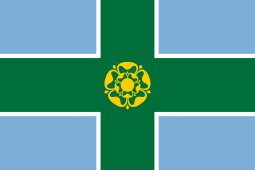Devonshire Royal Hospital
| The Devonshire Dome | |
|---|---|
 | |
| Former names | Devonshire Royal Hospital |
| General information | |
| Location | Buxton, Derbyshire |
| Coordinates | 53°15′36″N 1°55′00″W / 53.2600°N 1.9168°WCoordinates: 53°15′36″N 1°55′00″W / 53.2600°N 1.9168°W |
| Construction started | 1780 |
| Completed | 1789 |
| Renovated |
1858, Henry Currey 1881, Robert Rippon Duke 2001-3, University of Derby |
| Renovation cost | £4.7 million (2001-3) |
| Client | William Cavendish, 5th Duke of Devonshire |
| Owner | University of Derby |
| Dimensions | |
| Diameter | 44.2 metres (145 ft) |
| Technical details | |
| Floor area | 1,534 square metres (16,510 sq ft) |
| Design and construction | |
| Architect | John Carr |
| Website | |
| University of Derby, Buxton | |

The Devonshire Royal Hospital building (now popularly known as the Devonshire Dome) is a Grade II* listed[1] 18th-century former stable block in Buxton, Derbyshire. It was built by John Carr of York and extended by architect Robert Rippon Duke,[2] who added what was then the world's largest unsupported dome, with a diameter of 44.2 metres (145 ft). It is now the site of the Devonshire campus of the University of Derby.
History
Built between 1780 and 1789, the original building was designed by John Carr of York for William Cavendish, 5th Duke of Devonshire. Octagonal in shape, it housed up to 110 horses and the servants of the guests of the Crescent Hotel,[3] built in combination as part of the plan to promote Buxton as a spa town.[4]
In 1859, the Buxton Bath Charity had persuaded the Duke of Devonshire to allow part of the building – by then accommodating nothing like the 110 horses for which it was designed – to be converted to a charity hospital for the use of the ‘sick poor’ coming in for treatment from the ‘Cottonopolis’ of Lancashire and Yorkshire. The Devonshire estate architect, Henry Currey, architect for St Thomas’s Hospital in London, converted two thirds of the building into a hospital.[4]
In 1881, the Buxton Bath Charity trustees under their chairman Dr William Henry Robertson, persuaded William Cavendish, 7th Duke of Devonshire to give them the use of the whole building in exchange for providing new stables elsewhere in the town. Local architect Robert Rippon Duke was commissioned to design a 300-bed hospital to rival Bath and Harrogate for charity medical provision. The Cotton Districts Convalescent fund put up £25,000 for the conversion. The steel structure was clad in slate, and proposed to be supported by 22 curved steel arms. However, during construction the Tay Bridge disaster occurred on 28 December 1879, and so the number of arms was revised upwards. Railway engineer Mr Footner advised that the designers of the Tay Rail Bridge had not taken into account the stresses of lateral wind and storms.
Further changes were undertaken, with the clock tower and lodge completed in 1882, surgical wards in 1897, spa baths in 1913, and the dining room and kitchens in 1921. The building became known as the Devonshire Royal Hospital in 1934.[4]
The Devonshire Royal was the last of the eight hydropathic hospitals in England to close when it closed in 2000.
On 31 January 2001, the University of Derby acquired the Devonshire Royal Hospital. The University received £4.7m Heritage Lottery Fund backing for the restoration and redevelopment project.[4]
Dimensions
Included in Rippon Duke's design what was the world's largest unsupported dome with a diameter of 44.2 metres (145 ft); it surpassed that of the Pantheon (43 metres/141 ft) and St Peter's Basilica (42 metres/138 ft) in Rome, and St Paul's Cathedral (34 metres/112 ft). Overtaken by the West Baden Springs Hotel designed by Harrison Albright in 1902 (59.45 metres/195.0 ft), the record is now routinely surpassed today by space frame domes, such as the Georgia Dome (256 metres/840 ft), but the Devonshire is still the largest unsupported dome in the UK.[4] The dome has a floor area of 1,534m2.[5]
Today
Refurbished and reopened in 2003,[4] the main building and its surrounding Victorian era villas are now part of the University of Derby. It is being used routinely as a wedding venue, and exhibition space. Open to the public, the space houses cafés, shops, restaurants and study spaces, and visitors can observe the swing of a Foucault pendulum during certain times of the year.[3] The original spa of the hydropathic hospital has been reopened as a commercial spa centre offering a range of treatments and as a training venue for spa management and therapists.
On 23 October 2015, the venue played host to Jack Massey's defeat of Gogita Gorgiladze for the vacant WBC Youth Silver Title.
References
| Wikimedia Commons has media related to Buxton. |
- ↑ Entry at Images of England
- ↑ The History of Buxton, Vision Buxton, accessed February 2010
- 1 2 "The Devonshire Dome". visitbuxton.co.uk. Retrieved 2011-01-15.
- 1 2 3 4 5 6 "Inside Buxton's dome". BBC Derbyshire. June 2003. Retrieved 2010-01-25.
- ↑ "The Dome". University of Derby. Retrieved 2010-01-25.
External links
- University of Derby, Buxton
- 'At The Dome' Website
- Newsreel showing soldiers undergoing treatment in 1916
